Make Your Own Rope Halter
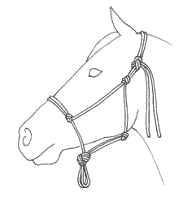
(courtesy of Natural Horse Magazine)
Tie a First Class Horse Rope Halter
By Connie Nygard
The advantage to using a thin rope on a horse is that it gives good control over a horse. The halter is light and comfortable while the horse is behaving but the thinness of the rope gives it some bite when the horse pulls. I find that it is better than a stud chain because it gives some control over the horse but is less likely to make a horse angry than a stud chain. The thin rope may look weak but it is a heck of a lot stronger than your arms and the horse is less likely to pull because it hurts the horse if he pulls. It is best used with a 12-foot lead rope for more leverage. I have used these rope halters for the past year and have had no problems with them.
CAUTION:
- Do not leave any halter on a loose horse.
- This halter may break if a horse is tied up with it.
- This halter may cut if a horse fights it.
- Not recommended for tying a horse in a trailer.
- Not responsible for misuse of halter.
Time
Time it took me to figure out how to tie this rope halter - 2 weeks. Money saved - minus $1000.
Time it takes me to tie a rope halter now - less than 15 minutes. Money saved - $20.
Time it will take you to learn from these instructions - Plus or minus 40 hours. Money saved - minus $1000. Money saved on all subsequent halters - $20 each.
Time it takes to tie a rope halter with a puppy helping you tighten the knots - 3 hours.
Materials needed
20 feet of 1/4-inch polyester rope. Matches to melt and seal the ends of rope (or to burn these instructions if you get frustrated).
Note: These directions are for an adult horse with a small head. I use 18 feet of rope but you may need more for a bigger head. If you get confused it is best to untie all knots and start over.
Directions
Tie simple knots at the distances shown below. Measurements are from knot to knot and do not include knot. Make the knots firm but not tight because you will be bringing the rope back around to tie into those knots. The last knot in about the middle of the rope is a knot with a loop for the tie loop of the halter. After you tie the tie loop you go back and tie into the knots you have already tied.

To tie into a knot, loosen knot and tie into knot following rope path.
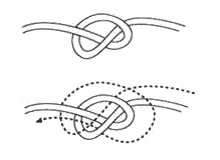
Tie into the left nose knot first. Then right nose knot to make a double rope over the nose.
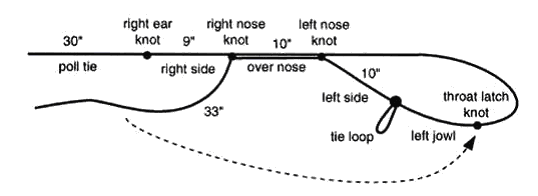
Tie into the throatlatch knot. Arrange halter as shown so it makes sense. And tie into the right ear knot.
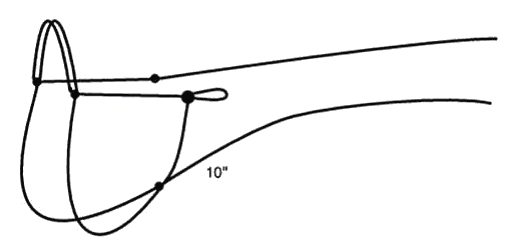
Gather the two 33" sections and tie a big ugly knot at the chin. Test all knots before putting halter on horse. If halter falls apart, knots are not tied correctly. Untie all knots and start over.
Slip knots to adjust size of halter. Trim tie ends the same length and melt them with a match to seal the ends. I don't attach the two ends together.
TIE KNOT 1


TIE KNOT 2 (easier to loosen)
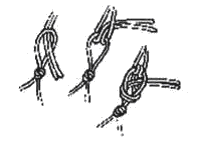

Just remember NOT to leave a halter on a loose horse. A horse should only be tied up when someone is around to help if the horse gets in trouble. These halters may cut if the horse fights being tied up. I will not be held responsible for misuse of the halter.
Halter notes: Materials - 1/4 or 5/16 yacht braid independently suggested as an alternative material for making halters.
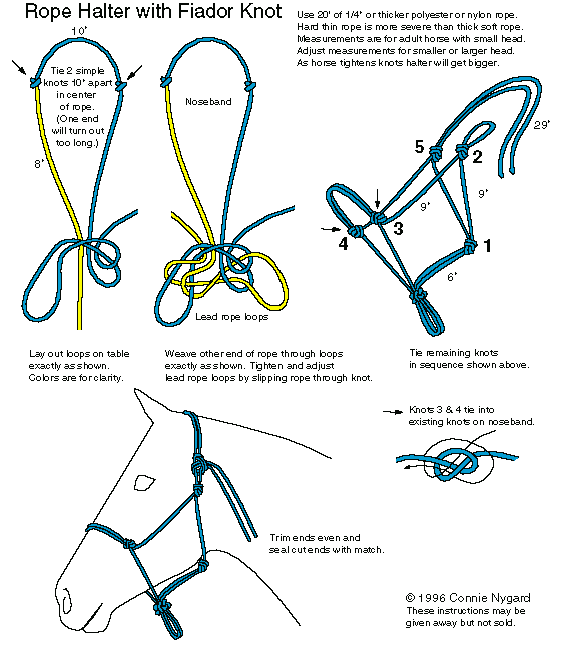
© 1995 to 2000 Connie Nygard - These instructions may be given away but not sold.




